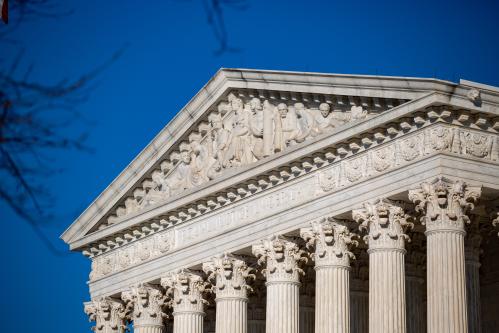The civics class model of the Supreme Court is that of an impartial adjudicator, above politics. It is an ideal still prized by the American public. Recently, however, the Supreme Court is looking more and more partisan. In a statement that reminds one of Shakespeare’s famous line, “the lady doth protest too much,” Justice Amy Coney Barrett proclaimed that “this court is not comprised of a bunch of partisan hacks.”
Nonetheless that is exactly what many are thinking. Barrett delivered this line in September 2021 at the University of Louisville’s McConnell Center, flanked by the Center’s namesake, Republican Senate Leader Mitch McConnell, who, a year before, had engineered her lightning-fast party-line confirmation eight days before the 2020 election. If anything, the net effect, noted in press accounts, was to amplify the “partisan hack” meme she sought to refute.
The impression of a highly politicized court is the result of decisions that flout bedrock principles of judicial comportment—norms such as meaningful respect for precedent, open and deliberative process, evidence-based, reasoned, and publicly explained decisions, deference to democratically elected or selected officials, and good faith fidelity to what relevant legal provisions say and what they have long been understood to mean.
For instance, on February 7 of this year, the Court, by a 5-4 vote, bypassed regular order to suspend implementation of a unanimous ruling by a panel of three lower court judges—two Trump appointees and one Obama appointee. The panel had held that the 1965 Voting Rights Act required invalidation of the Alabama legislature’s 2022 congressional election district map; that map yielded one black representative and six white representatives, although blacks constitute 27% of the state’s voters. The extraordinary intervention—by Justices Clarence Thomas, Samuel Alito, Neal Gorsuch, Brett Kavanaugh, and Amy Coney Barrett—infuriated, not only the three liberal justices—Stephen Breyer, Sonia Sotomayor, and Elena Kagan—but conservative Chief Justice John Roberts. Roberts scolded his customary allies—“The district court properly applied existing law in an extensive opinion with no apparent errors for our correction.”
In effect, the five-justice majority had rushed to nullify longstanding statutory ballot access guarantees designed to protect an essential Democratic constituency, applicable nationwide, months before the 2022 congressional elections. The prevailing justices used an expedited procedure traditionally reserved for rare and genuine emergencies. In this instance, the procedure afforded a drastically foreshortened opportunity for briefing to acquaint the justices with the circumstances of the case, no opinion for the Court, nor any articulated rationale.
Justice Sonia Sotomayor had, during an oral argument two months earlier, sharply censured the conservative bloc’s similarly irregular intervention to sideline longstanding abortion rights protections. “Can this institution survive,” Sotomayor fairly spat out, “the stench that this creates in the public perception that the constitution and its reading are just political acts?”
The public seems to be catching that scent. An October 2021 Grinnell College poll found that “62 percent of respondents believed that the Supreme Court’s decisions are driven by politics rather than the U.S. Constitution and the law.”
There is good cause for concerned justices, pundits, and public poll respondents to see the conservative members’ latest maneuvers as a sharp turn towards ostentatious partisanship. For many, the Court’s audacious abuse of the “shadow docket”—its procedures for disposing of emergency applications to interrupt regular order lower court consideration of matters—is another example of politicization. As Texas law professor Stephen Vladeck has documented, the new majority has not only exponentially increased the frequency of shadow docket decisions, but repeatedly deployed that truncated procedure to deliver law-changing, hugely consequential blockbusters. The decision noted above, greenlighting Alabama Republicans’ Voting Rights Act-defying gerrymander, is one of an expanding array of examples.
As President George H.W. Bush’s Deputy Attorney General Donald Ayer observed, “What is new is the court’s frequency and brashness in achieving these radical outcomes, and its willingness to do so often without an honest explanation and acknowledgement of what is actually going on.”
In addition to breaching established procedural guardrails, the conservative justices have increasingly disregarded conventions aimed at constraining, or at least veiling judges’ partisan leanings. For example, in November 2020, Justice Alito forayed off the bench to deliver a widely reported, “unusually caustic and politically tinged speech,” in the words of New York Times’ Supreme Court correspondent Adam Liptak. Liptak observed—“While Chief Justice John G. Roberts Jr. has tried to signal that the Supreme Court is apolitical, Justice Alito’s comments sent a different message.”
The most noted recent embarrassment for the Court’s nonpartisan claims arose from Justice Thomas’ spouse, Ginni Thomas’ immersion in far-right political mobilization. Her activities, which included helping orchestrate the January 6, 2021 effort to overturn the 2020 election, involve myriad causes, organizations, and individual contacts with direct and indirect stakes in major cases that have and will likely come before the Supreme Court. Justice Thomas has repeatedly rebuffed requests and suggestions to recuse from cases and avoid events off the Court involving or affecting her interests. His refusals may not violate ethics prohibitions currently on the books. But, however that may be, the couple’s conduct breaches constraints voluntarily observed by almost all federal judges, including Justice Thomas’ high court colleagues, and their spouses.
To be sure, the liberal side has also reinforced public perceptions of partisanship, particularly on one highly publicized occasion—the late Justice Ruth Bader Ginsburg’s July 2016 jab at GOP presidential candidate Donald Trump as a “faker.” (Justice Ginsburg apologized for this “ill-advised remark,” and promised in the future to be more “circumspect.”)
What can be done?
The conservative bloc’s attraction to ethically questionable methods could present a significant opportunity for liberals, and others uneasy with the legal right’s substantive agenda for, in Professor Fried’s terms, “taking a wrecking ball . . . to generations of Supreme Court doctrine.” At present, the principal remedy touted by court-focused liberal advocates is legislation to expand the number of Supreme Court slots. But that proposal stands no foreseeable chance of enactment. And after languishing for more than a year, this strategy apparently lacks deterrent value; the conservative justices’ accelerating norm-breaking penchant indicates that they dismiss “court-packing” as an empty threat.
There is a better way—advocates should feature an item further down their list of possible court reforms—strengthening judicial ethics, conflict of interest, and good practice and procedure standards. Spotlighting these issues, and proposing to update and tighten existing requirements, would be more constructive, more likely to attract broad congressional support, and to resonate more broadly with the public. If judicial ethics reform measures meet stiff Republican resistance, ensuing battles could be framed to alert constituencies whose pocket-book, health, safety, and environmental interests are threatened by the judicial right’s “wrecking ball” project.
Already, Congress is attuned to the inadequacy of judicial ethics safeguards. Indeed, virtually identical versions of a Courthouse Ethics and Transparency Act have passed both houses, with bipartisan sponsorship and near-unanimous member support. When this bill reaches the President’s desk, it will be the first legislation to overcome decades of resistance by the federal judiciary to externally imposed or administered ethics measures.
Of course, the current legislation merely streamlines public access to financial disclosures already required by law. But it could presage receptivity to broader legislation. Congress’ bipartisan action constitutes emphatic rejection, for the first time in decades, of federal judges’ perennial insistence that they can be trusted to police themselves. Effective leadership could make this success a first step toward getting Congress comfortable with embracing its long-neglected constitutional role of checking a third branch, that, increasingly, is bent on usurping power that should rest with Congress itself, as well as the Executive branch, and state and local governments.
Granted, a Congressional effort to address alleged partisan or politically driven judicial conflicts of interests, improper procedures, and extracurricular political activity could be a heavy lift politically. Shaping sensible but effective proposed solutions could prove complicated. But taking on such challenges would target a problem already concerning the electorate, the media, and academic and other experts. Crafting remedies applicable to Democratic and Republican appointees alike could confer credibility and put supporters on the high ground.
Once the pending bipartisan legislation becomes law, Democrats could push for action on a bill, the Supreme Court Ethics Act, introduced in July of last year, by Democrats in both houses. This one-page proposal would direct the Judicial Conference of the United States to promulgate a code of conduct applicable to all federal judges, including Supreme Court justices. Currently, since 1973, the most detailed ethical rules governing federal judges consists of a “Code of Conduct” written by the Judicial Conference. Enforced by designated judicial authorities, that code covers all federal judges – with one glaring exception—the Code expressly does not apply to the Supreme Court.
Prioritizing this simple proposal would be worthwhile, for several reasons. On the merits, it is an easy sell. Virtually no one, certainly no ordinary voter would consider it tenable that Supreme Court justices are the only federal judges not subject to an enforceable ethical code. Chief Justice Roberts’ insistence that no such code is necessary is belied by his colleagues’ appetite for provocative behaviors that he surely does not approve but is powerless to prevent. More specifically, Roberts has argued that Supreme Court justices face special circumstances not accommodated by some provisions of the Judicial Conference Code of Conduct. But the Democrats’ bill moots that criticism, by authorizing Code provisions applicable only to “certain categories of judges or justices.”
Finally, the conservative justices have themselves pulled the rug out from under their fundamental excuse for avoiding ethical safeguards. As judges with the final word in divining relevant law and doing justice, they assert, Supreme Court justices uniquely require independence from external oversight. But the reason for escalating perceptions of partisanship and politicization is precisely the Court’s escalating aggrandizement of its own power. Ever more visibly, this court has taken it upon itself to determine the fate of virtually every major new federal law, regulation, or policy, and important state and local laws and policies, including measures adopted decades, even a century or more ago, and upheld ever since. Defenders of such measures now confront justices poised to scrap, gut, or rewrite them on the basis of novel, often dubious legal theories that neither they nor enacting legislators could anticipate.
At bottom, emerging interest in tighter Supreme Court ethics guardrails is an inevitable incident of the collision between this court’s expanding policy and political footprint, and the civics class impartial adjudicator model. Elaborating the case for applying ethical conduct rules to the Supreme Court would present a valuable messaging opportunity—to showcase how starkly the current majority’s agenda departs from that widely resonant ideal, and detail the lengthening trail of decisions that undermine, cancel, or threaten legal guarantees critical to everyday Americans.





Commentary
How to rein in partisan Supreme Court justices
March 23, 2022